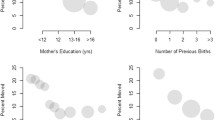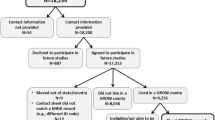Abstract
Objectives
Researchers often examine neighborhood socioeconomic environment and health during the perinatal period using geocoded addresses recorded on birth certificates at the time of delivery. Our objective was to assess the potential for post-partum neighborhood misclassification by examining whether women move neighborhoods during the immediate post-partum period, whether they move to neighborhoods of different socioeconomic status (SES), and whether mobility differs by maternal characteristics.
Methods
We used data from the 2003–2007 California Maternal and Infant Health Assessment (MIHA), an annual, statewide-representative survey of post-partum women, to examine women’s neighborhood mobility patterns between giving birth and completing a survey 2–7 months post-partum. We examined whether women changed neighborhoods, whether moves were to neighborhoods of higher, lower, or similar socioeconomic status (SES), and whether these patterns differed by maternal race/ethnicity, maternal SES, or other demographic characteristics.
Results
Overall, 93 % of women either did not move neighborhoods or moved to a neighborhood of similar SES post-partum. Only 4 % of women moved to a neighborhood of lower SES and 3 % to an area of higher SES. Mothers who were non-Hispanic black or US-born Hispanic, young, unmarried, primiparous, or lower SES were slightly more likely to move overall and more likely to move to neighborhoods with different SES, compared to other women.
Conclusions
These findings suggest that geocoded addresses from birth certificates can be used to estimate women’s neighborhood SES during the early post-partum period with little misclassification, an especially relevant finding for researchers using post-partum surveys.
Similar content being viewed by others
References
Cubbin, C., Marchi, K., Lin, M., et al. (2008). Is neighborhood deprivation independently associated with maternal and infant health? Evidence from Florida and Washington. Maternal and Child Health Journal, 12(1), 61–74.
Messer, L. C., Kaufman, J. S., Dole, N., et al. (2006). Neighborhood crime, deprivation, and preterm birth. Annals of Epidemiology, 16(6), 455–462.
Metcalfe, A., Lail, P., Ghali, W. A., et al. (2011). The association between neighbourhoods and adverse birth outcomes: A systematic review and meta-analysis of multi-level studies. Paediatric and Perinatal Epidemiology, 25(3), 236–245.
O’Campo, P., Burke, J. G., Culhane, J., et al. (2008). Neighborhood deprivation and preterm birth among non-Hispanic Black and White women in eight geographic areas in the United States. American Journal of Epidemiology, 167(2), 155–163. doi:10.1093/aje/kwm277.
Fell, D. B., Dodds, L., & King, W. D. (2004). Residential mobility during pregnancy. Paediatric and Perinatal Epidemiology, 18(6), 408–414.
Lupo, P. J., Symanski, E., Chan, W., et al. (2010). Differences in exposure assignment between conception and delivery: The impact of maternal mobility. Paediatric and Perinatal Epidemiology, 24(2), 200–208.
Sundquist, J., Sundquist, K., Johansson, S.-E., et al. (2011). Mothers, places and small for gestational age births: A cohort study. Archives of Disease in Childhood, 96(4), 380–385.
Schluter, P. J., Ford, R. P. K., Mitchell, E. A., et al. (1998). Residential mobility and sudden infant death syndrome. Journal of Paediatrics and Child Health, 34(5), 432–437.
Urayama, K. Y., Von Behren, J., Reynolds, P., et al. (2009). Factors associated with residential mobility in children with leukemia: Implications for assigning exposures. Annals of Epidemiology, 19(11), 834–840.
Saadeh, F., Clark, M., Rogers, M., et al. (2013). Pregnant and moving: Understanding residential mobility during pregnancy and in the first year of life using a prospective birth cohort. Maternal and Child Health Journal, 17(2), 330–343.
Rinki, C., Martin, K., & Curtis, M. (2012). 2010 MIHA County Report: A summary report of county snapshots and geographic comparisons from the Maternal and Infant Health Assessment Survey. Sacramento, CA: California Department of Public Health, Maternal, Child and Adolescent Health Program.
Messer, L. C., Vinikoor-Imler, L. C., & Laraia, B. A. (2012). Conceptualizing neighborhood space: Consistency and variation of associations for neighborhood factors and pregnancy health across multiple neighborhood units. Health and Place, 18(4), 805–813.
Winkleby, M., Cubbin, C., & Ahn, D. (2006). Effect of cross-level interaction between individual and neighborhood socioeconomic status on adult mortality rates. American Journal of Public Health, 96(12), 2145–2153.
Schachter, J. P., & Kuenzi, J. J. (2002). Seasonality of moves and the duration and tenure of residence: 1996. Working Paper No. 69. Census Bureau Population Division. http://www.census.gov/population/www/documentation/twps0069/twps0069.pdf. Accessed 2 Oct 2014.
Acknowledgments
This work was supported by a grant from the American Cancer Society (RSGT-11-010-01-CPPB) to C. Cubbin.
Author information
Authors and Affiliations
Corresponding author
Rights and permissions
About this article
Cite this article
Margerison-Zilko, C., Cubbin, C., Jun, J. et al. Post-partum Residential Mobility Among a Statewide Representative Sample of California Women, 2003–2007. Matern Child Health J 20, 139–148 (2016). https://doi.org/10.1007/s10995-015-1812-0
Published:
Issue Date:
DOI: https://doi.org/10.1007/s10995-015-1812-0




